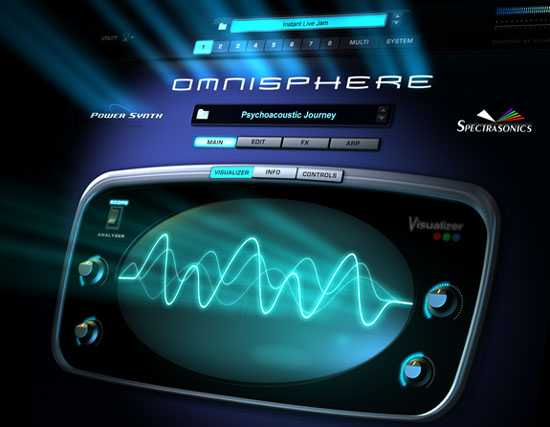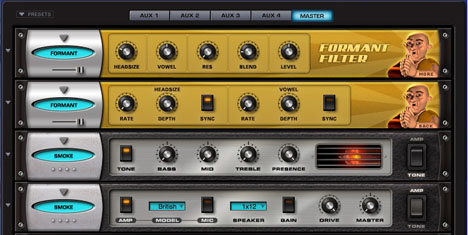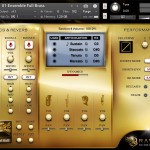[click]
“Oooh!”
[click]
“Woah…”
[click]
“Wow, that’s weird!”
[click]
“Oh, I’m so going to use this later.”
[click]
…
Take this type of scene of auditioning patches, and then stretch it out over several days, and you’ll have some idea of what our review time with Spectrasonics’ Omnisphere was like. Of course, this began after I managed to cram all 42+ GB of sample data onto the test workstation. We won’t talk about how long that took.
This new virtual instrument is technically the follow-up and replacement to Atmosphere, Spectrasonics’ previous mega-sound bank, but as far as features and size goes, there is no comparison. Sure, their new flagship synth is massive, but it’s also packing crazy power for synthesis and effects processing.
Patch Editing
Upon opening up Omnisphere, you’re greeted with a splash screen, and then a patch browser. There are thousands of patches and dozens of categories to twiddle with, but we’ll get to this in a bit.
After picking a patch, you’re able to dig in deep by hitting the “edit” tab, taking the lid off their STEAM engine. Under it, you’ll find a wealth of options that prove that this isn’t just some big ROMpler. Most of the patches are made with two layers, both of which you can edit and tweak to your heart’s delight under this tab. Presets are made from either one of the gazillions of waveforms included, acting as an “oscillator,” or straight from internally-generated synthesis. Mix and match, make your own patches, and giggle under your breath at the power before you..
When you’ve got something you like, modify it with selectable FM modulation, wave shaping, ring modulation and much more. Filter away with high-pass, low-pass, and selectable filters, editing envelopes in either a basic ADSR mode or a nice graphical interface.
You’re not even close to done messing with this patch, though. The next tab over is called “FX.” Under it, you’ll be able to delay, limit, compress, reverb, or EQ your creation by loading effects into each layer’s virtual rack. There are also rack “AUX Sends” for more shared effects, allowing you to further maul your sound.
Finally, load up the appregiator. You will not believe the wealth of options packed into this section. There’s 32 steps for you to trigger by default, and you can edit the general behavior, note lengths and more here. I spent hours playing with the most basic patches, tempo-locking them and then tweaking under the “ARP” pad. You can even drag-and-drop midi files into the ARP to match their feel to your patch with a tool called “Groove Lock.” It works with any MIDI File as well as MIDI Files from Stylus RMX.
All of this falls under editing one patch. If that doesn’t give you some kind of indication to the massive scale of this virtual instrument, I don’t know what will.
Also, Omnisphere is multibimbral, allowing you to load 8 patches per instance. A handy “Multi” window lets you see all 8 patches, with independent volume control, aux sends, and even drop down boxes to assign patches to any of the virtual outputs. They couldn’t have made it any easier.
In Use
There’s no way to summarize the soundset with words as far Omnisphere goes. Its predecessor, Atmosphere, sounded… well, atmospheric. But there’s just too many sounds in Omnisphere to sum it all up. Spacey, wordly, and beautiful come to mind, but even then, these descriptors are leaving out a good deal of the other patches. Thankfully, the patch browser was smartly divided into sound types and usage types. By selecting these tag filters, you’re better able to plow through the thousands of sounds to find what you need. And, for the times that you’re feeling lucky, a randomizer button will throw up a randomized list of patches. It hasn’t disappointed me yet.
While the soundset is pretty far away from your typical “bread and butter” ROMpler, there are some good, solid “use me often” sounds. All of Atmosphere is in the mix, so all of those lovely strings and pads are somewhere in there, some upgraded. It doesn’t get more “bread and butter” than acoustic guitars, but the variants included are stunning. I came across a blend of an old D50 bell patch and piano recorded in a live hall, and I fell in love. I must have played that one patch for a good hour straight. There’s also electric pianos, one-hit drums, and synth leads, but those are probably not the sounds you’re most excited about, right?
There are some weird sounds in Omnisphere. There’s actually a sampled burning piano in the mix, and while that sounds pretty dangerous, it’s a lot of fun to play. Instant backwards pianos are here, too. Electronic noises, sweeps, and tweets play nicely alongside organic pads and shimmering bells. And the choirs and choir blends are heavenly.
Speaking of choirs, these may remind you of something you’ve heard before. Within the massive selection of new goodies comes “greatest hits” and modified versions of patches from older libraries, like Symphony of Voices, Hanz Zimmer Guitars, Vocal Planet, Distorted Reality and more. Add these to the already fantastic Atomsphere, and you have one hell of a bargain for the asking price.
In Summary
There’s no way we could lay out all that Omnisphere contains in an orderly and timely fashion. Despite being a virtual instrument, it’s one that actually needs some “hands-on” time to appreciate. Or you could just listen to it, and be blown away. The sound quality is polished and brilliant, so much so that you may find yourself worrying about how your other soundsets will compare alongside it.
There’s not much to complain about here. Installation is a bitch, requiring multiple DVDs to be loaded. There’s really no way around this yet, save for libraries being shipped on hard disks. And, as would be expected with something this powerful, you’re going to need some serious CPU cycles to get the most out of Omnisphere. Our quad-core test workstation got along well enough, but watching the CPU meters in the sequencers gave a pretty good indication that lesser computers would have some trouble [minimum requirements listed below..
Omnisphere is one hell of a creation. For something that comes off of DVDs, it’s surprisingly organic and instrument-like, not to mention insanely powerful. Loading up and playing Omnisphere seems a lot like playing a really powerful hardware synthesizer, except with a massive soundbank and a sound quality that hardware has yet to touch. While it may not contain those “bread and butter” sounds that your typical virtual instrument may, we feel confident in saying that Omnisphere will be your go-to sound source, and the others will pale in comparison. Spectrasonics has definitely raised the bar with this one.
[System Req]
SYSTEM REQUIREMENTS FOR ALL USERS:
• 2GB or more of RAM
• Dual Layer compatible DVD-ROM drive
• 50GB of free hard drive space
Mac Recommendations:
• 2.0 GHz or higher processor
• G5 PowerPC compatible – Intel Core2Duo or higher recommended
• OSX 10.4.9 or higher
• AudioUnit, VST 2.4 or RTAS capable host software
• Native Universal Binary for Intel Macs
Windows Recommendations:
• Pentium 3.0 GHz or higher (Intel Core2Duo recommended)
• VST 2.4 or RTAS capable host software
• Microsoft XP SP2 or later
• Microsoft Vista compatible
ALSO: links and pricing:
Omnisphere link: http://www.spectrasonics.net/instruments/omnisphere.html
MSRP: $499. US
Upgrades from Atmosphere are available: https://techshop.spectrasonics.net/omnisphereUpgrade.php











































Wow. Sounds awesome. I should have reviewed this! ;D
That burning piano sounds awesome. Looking forward to seeing this one in action.
I tried this at a friends house during the week. It is the first time in a long time I have been inspired by new sounds. So many hardware synths seem to contain the same stuff these days. Omnisphere is literally gorgeous to listen too and play.